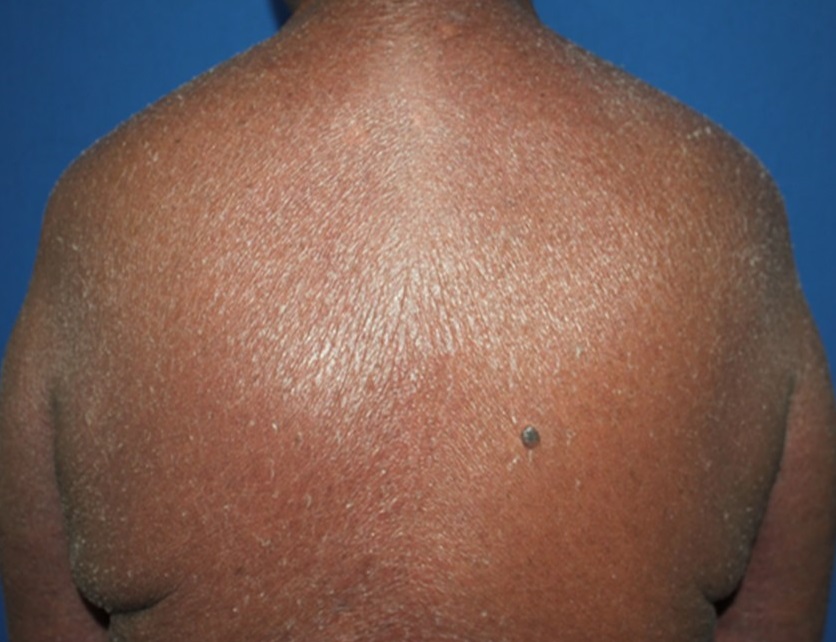A Rare Case of Sézary Syndrome: Leukemic Variants of Cutaneous T-cell Lymphoma
Keywords:
Cutaneous T-cell lymphoma, Erythroderma, Sézary syndromeAbstract
Sézary syndrome (SS) is a rare form of leukemic variants of cutaneous T-cell lymphoma. Diffuse erythroderma, generalized lymphadenopathy, and evidence of cutaneous involvement and leukemic component are the classic triad of SS. We report a 66-year-old Thai woman initially presented with erythroderma without preceding clinical of patches and plaques for 2 years. After the initial skin biopsy, she was misdiagnosed as generalized eczema. Eight months later, despite treatment, the lesion worsened and still has presented erythroderma with bilateral inguinal lymphadenopathy. A second skin biopsy showed atypical lymphocytes with epidermotropism and Pautrier microabscess formation. Blood flow cytometry demonstrated Sézary cells and the presence of monoclonal T-cell receptor gene rearrangement in the blood was relevant to clone in the skin. She was diagnosed with SS and treated with acitretin, methotrexate, and PUVA. After 6 months of treatment, the lesion partially responded. Unfortunately, the patient passed away due to Covid-19 pneumonia.
References
Jawed SI, Myskowski PL, Horwitz S, Moskowitz A, Querfeld C. Primary cutaneous T-cell lymphoma (mycosis fungoides and Sézary syndrome): part I. Diagnosis: clinical and histopathologic features and new molecular and biologic markers. J Am Acad Dermatol 2014;70:205.e1-16.
Larocca C, Kupper T. Mycosis Fungoides and Sézary Syndrome: An Update. Hematol Oncol Clin North Am 2019;33:103-20.
Bogen SA, Pelley D, Charif M, McCusker M, Koh H, Foss F, Garifallou M, Arkin C, Zucker-Franklin D. Immunophenotypic identification of Sezary cells in peripheral blood. Am J Clin Pathol 1996;106:739-48.
Ng PP, Goh CL. Sezary syndrome: a case report and a review of the molecular pathomechanism and management. Ann Acad Med Singap 1998;27:864-7.
Kohler S, Kim YH, Smoller BR. Histologic criteria for the diagnosis of erythrodermic mycosis fungoides and Sézary syndrome: a critical reappraisal. J Cutan Pathol 1997;24:292-7.
Willemze R, Cerroni L, Jaffe ES, et al. The 2018 update of the WHO-EORTC classification for primary cutaneous lymphomas. Blood 2019;133:1703-14.
rotter MJ, Whittaker SJ, Orchard GE, Smith NP. Cutaneous histopathology of Sézary syndrome: a study of 41 cases with a proven circulating T-cell clone. J Cutan Pathol 1997;24:286-91.
Jonak C, Tittes J, Brunner PM, Guenova E. Mycosis fungoides and Sézary syndrome. J Dtsch Dermatol Ges 2021;19:1307-34.
Sanches JA, Cury-Martins J, Abreu RM, Miyashiro D, Pereira J. Mycosis fungoides and Sézary syndrome: focus on the current treatment scenario. An Bras Dermatol 2021;96:458-71.
Trautinger F, Eder J, Willemze R, et al European Organisation for Research and Treatment of Cancer consensus recommendations for the treatment of mycosis fungoides/Sézary syndrome - Update 2017. Eur J Cancer 2017;77:57-74.

Downloads
Published
How to Cite
Issue
Section
License
Copyright (c) 2023 Thai Journal of Dermatology

This work is licensed under a Creative Commons Attribution-NonCommercial-NoDerivatives 4.0 International License.
เนื้อหาและข้อมูลในบทความที่ลงตีพิมพ์ในวารสารโรคผิวหนัง ถือเป็นข้อคิดเห็นและความรับผิดชอบของผู้เขียนบทความโดยตรงซึ่งกองบรรณาธิการวารสาร ไม่จำเป็นต้องเห็นด้วย หรือร่วมรับผิดชอบใดๆ
บทความ ข้อมูล เนื้อหา รูปภาพ ฯลฯ ที่ได้รับการตีพิมพ์ในวารสารโรคผิวหนัง ถือเป็นลิขสิทธิ์ของวารสารฯ หากบุคคลหรือหน่วยงานใดต้องการนำทั้งหมดหรือส่วนหนึ่งส่วนใดไปเผยแพร่ต่อหรือเพื่อกระทำการใดๆ จะต้องได้รับอนุญาตเป็นลายลักอักษรจากบรรณาธิการวารสารโรคผิวหนังก่อนเท่านั้น


